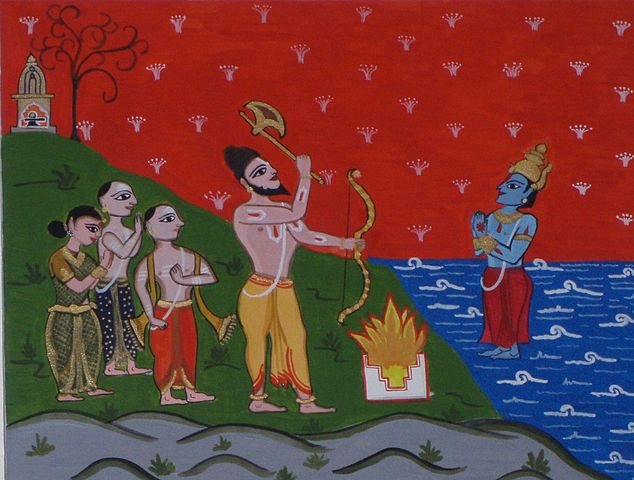 |
This is a file from the Wikimedia Commons. Information from its description page there is shown below.
Commons is a freely licensed media file repository. You can help.
|
 |
This file was moved to Wikimedia Commons from en.wikipedia using a bot script. All source information is still present. It requires review. Additionally, there may be errors in any or all of the information fields; information on this file should not be considered reliable and the file should not be used until it has been reviewed and any needed corrections have been made. Once the review has been completed, this template should be removed. For details about this file, see below. Check now! |
| Description |
English: This painting showing Lord en:Parasurama, an avatar of Lord Vishnu asking Lord en:Varuna, God of the waters to recede to make land known as Kerala from Kanyakumari to Gokarna for the Brahmins. A number of myths and legends persist concerning the origin of Kerala. One such myth is the creation of Kerala by Parasurama, a warrior sage. The Brahminical myth proclaims that Parasurama, an avatar of Mahavishnu, threw his battle axe into the sea. As a result, the land of Kerala arose and was reclaimed from the waters.Parasurama was the incarnation of Maha Vishnu. He was the sixth of the ten avatars (incarnation) of Vishnu. The word Parasu means 'axe' in Sanskrit and therefore the name Parasurama means 'Ram with Axe'. The aim of his birth was to deliver the world from the arrogant oppression of the ruling caste, the Kshatriyas. He killed all the male Kshatriyas on earth and filled five lakes with their blood. After destroying the Kshatriya kings, he approached assembly of learned men to find a way of penitence for his sins. He was advised that, to save his soul from damnation, he must hand over the lands he had conquered to the Brahmins. He did as they advised and sat in meditation at Gokarna. There, Varuna -the God of the Oceans and Bhumidevi - Goddess of Earth blessed him. From Gokarna he reached Kanyakumari and threw his axe northward across the ocean. The place where the axe landed was Kerala. It was 160 katam (an old measure) of land lying between Gokarna and Kanyakumari. Puranas say that it was Parasuram who planted the 64 Brahmin families in Kerala, whom he brought down from the north in order to expiate his slaughter of the Kshatriyas. According to the puranas, Kerala is also known as Parasurama Kshetram, ie., 'The Land of Parasurama', as the land was reclaimed from sea by him.
|
| Date |
21 October 2007 (original upload date) |
| Source |
Transferred from en.wikipedia; transferred to Commons by User:Roland zh using CommonsHelper. |
| Author |
Original uploader was Drshenoy at en.wikipedia |
Permission
( Reusing this file) |
Licensed under the GFDL by the author; GFDL-SELF-NO-DISCLAIMERS; Released under the GNU Free Documentation License.
|
Licensing
Drshenoy at the English language Wikipedia, the copyright holder of this work, hereby publishes it under the following license:
 |
Permission is granted to copy, distribute and/or modify this document under the terms of the GNU Free Documentation License, Version 1.2 or any later version published by the Free Software Foundation; with no Invariant Sections, no Front-Cover Texts, and no Back-Cover Texts. A copy of the license is included in the section entitled GNU Free Documentation License. http://www.gnu.org/copyleft/fdl.htmlGFDLGNU Free Documentation Licensetruetrue
|
|
I, the copyright holder of this work, hereby publish it under the following license:
 |
Permission is granted to copy, distribute and/or modify this document under the terms of the GNU Free Documentation License, Version 1.2 or any later version published by the Free Software Foundation; with no Invariant Sections, no Front-Cover Texts, and no Back-Cover Texts. A copy of the license is included in the section entitled GNU Free Documentation License. http://www.gnu.org/copyleft/fdl.htmlGFDLGNU Free Documentation Licensetruetrue
|
|
File usage
The following pages on Schools Wikipedia link to this image (list may be incomplete):
This file contains additional information, probably added from the digital camera or scanner used to create or digitize it. If the file has been modified from its original state, some details may not fully reflect the modified file.




